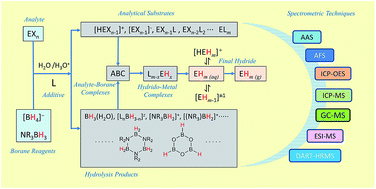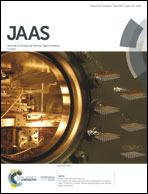The contribution of chemical vapor generation coupled with atomic or mass spectrometry to the comprehension of the chemistry of aqueous boranes
Abstract
The degree of knowledge of the mechanisms operating in chemical vapor generation (CVG) by aqueous boranes (MBH4, R3N·BH3, M = Na, K and R = H, alkyl) for trace element determination by atomic or mass spectrometry, have been reviewed in the light of the most recent evidence. The attention has been mainly focused on the role played by sample composition – acidity, type of acid or buffer and chemical additives – in the control of the mechanism of CVG of volatile hydrides (Ge, Sn, Pb, As, Sb, Bi, Se, Te, Hg and Cd) under analytical conditions (analyte < 10−6 mol L−1, borane ≥ 10−2 mol L−1) in the absence of interfering species. The available evidence is reported in order to discuss the role played in CVG by some key chemical species, among them the hydrolysis products of borane reagents. Particular emphasis was given to those mechanistic aspects of the chemistry of aqueous boranes that have been clarified thanks to the contribution of CVG coupled with atomic or mass spectrometry, to those that are still controversial and that could stimulate further studies to understand the reactivity of aqueous boranes also for their applications other than CVG.

- This article is part of the themed collections: Recent Review Articles and JAAS Recent HOT articles


 Please wait while we load your content...
Please wait while we load your content...